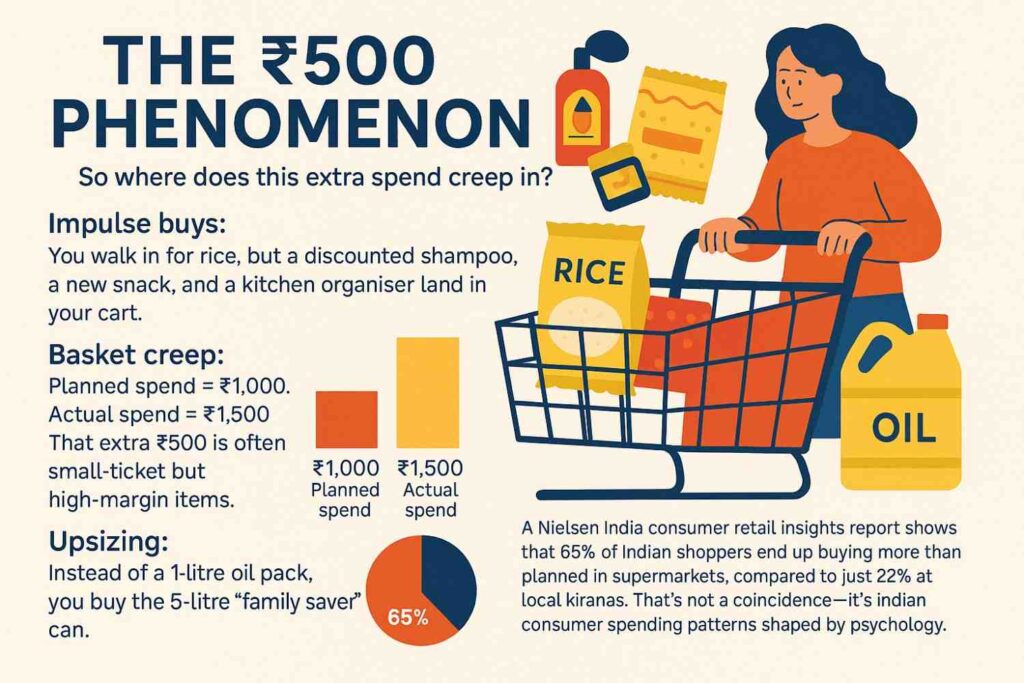Table Of Content
Walk into any DMart on a weekend and you’ll see the same scene: long queues, overflowing trolleys, and shoppers with the same dazed look—how did my bill get this high? You probably entered the store planning to buy just rice, oil, and a few daily essentials. Yet when the cashier hands you the final bill, it’s at least ₹500 more than you expected.
This isn’t carelessness. It’s design. Indian supermarkets like DMart have mastered the art of consumer psychology in India by blending subtle science with cultural insights to ensure you always spend more than planned.
Let’s decode why this happens, and what it reveals about Indian consumer behavior.
The Rise of Supermarket Culture in India
A decade ago, grocery shopping in India meant visiting the neighborhood kirana. Today, organised retail chains are everywhere—from metros to Tier 2 and Tier 3 cities.
DMart leads this revolution, with 340+ stores across India and an average annual revenue per store of over ₹100 crore, according to the DMart Annual Report 2024. Reliance Smart, More, and Spencer’s are expanding aggressively too, taking advantage of the organised retail growth in India projected by IBEF.
The appeal is simple: supermarkets promise lower prices, wider variety, and a better shopping experience. But behind that promise lies a carefully engineered ecosystem designed to influence your behavior. This is not just business—it’s a masterclass in Indian market entry framework.
The ₹500 Phenomenon

So where does this extra spend creep in?
- Impulse buys: You walk in for rice, but a discounted shampoo, a new snack, and a kitchen organiser land in your cart.
- Basket creep: Planned spend = ₹1,000. Actual spend = ₹1,500. That extra ₹500 is often small-ticket but high-margin items.
- Upsizing: Instead of a 1-litre oil pack, you buy the 5-litre “family saver” can.
A Nielsen India consumer retail insights report shows that 65% of Indian shoppers end up buying more than planned in supermarkets, compared to just 22% at local kiranas. That’s not a coincidence—it’s Indian consumer spending patterns shaped by psychology.
The Science of Store Psychology
Supermarkets aren’t just warehouses. They’re behavioral laboratories. Every shelf, signboard, and discount label is crafted to nudge you.
1. Store Layouts
Essentials like rice, atta, and oil are always kept at the back. Why? Because you’ll walk past 20 other categories before you reach them, increasing the chance of unplanned purchases. Fresh fruits and vegetables at the entrance create a “healthy start” effect, making you feel less guilty about slipping chips into your cart later.
2. Visual Merchandising
- Premium brands sit at eye level, where your attention naturally falls.
- Local or budget options are placed lower, forcing you to bend—a subtle discouragement.
- End-of-aisle displays push seasonal goods, from Diwali gift packs to Holi colors.
3. The Illusion of Savings
Indians love a bargain. DMart plays to this by advertising “everyday low prices,” making you feel like you’re always saving. Psychologists call this the anchoring effect: when you see an MRP of ₹100 and a sale price of ₹79, your brain focuses on the ₹21 “saved” rather than the ₹79 spent.
Compare this with Big Bazaar’s old model of “sale days.” Customers waited for the next big sale instead of shopping regularly. DMart flipped the script—low prices every day—building habit and trust.
4. Queue Psychology
The checkout line is a goldmine. Those racks filled with chocolates, masala sachets, face wipes, and batteries? They account for a huge share of impulse revenue. You’re bored, you’re waiting, and suddenly that ₹50 Cadbury bar feels like a harmless add-on.
Why Indian Shoppers Fall for These Nudges
The Indian consumer is uniquely shaped by scarcity, savings, and social proof. Here’s why these tactics work so well here:
- Value-for-money mindset: Our cultural pride is tied to being a “smart shopper.” Buying more at less cost = social validation.
- Loss aversion: Indians hate “missing out” on a deal. That’s why “Buy 1 Get 1 Free” feels irresistible, even if you didn’t need two.
- Anchoring to MRP: Because India has MRP printed on every pack, the contrast between MRP and DMart’s price feels like a win.
- Social psychology: When everyone around you is pushing giant carts, it subconsciously feels normal to do the same.
In essence, DMart isn’t making you spend more—it’s making you feel good about spending more. This is the real heart of Indian consumer insights.
DMart’s Winning Formula
Why does DMart succeed where others failed?
- Everyday Low Prices: Instead of flashy discounts, they focus on consistent savings.
- Limited Assortment: You won’t find 20 types of ketchup. Just 2-3 options—making decisions faster.
- Tier 2 & Tier 3 dominance: DMart’s DNA is rooted in Bharat’s heartland, where “savings per rupee” drives loyalty.
- Lean operations: Their stores are no-frills, cutting costs to pass on real savings.
Compare this to Big Bazaar, which bet on mall-like experiences and festive sales. When discounts stopped, customers drifted away. DMart, by contrast, thrives on habit, not hype.
Lessons for Entrepreneurs & Retailers
The psychology behind DMart’s success isn’t limited to supermarkets. Any Indian entrepreneur can apply these lessons:
- Product placement matters: Whether online or offline, showcase premium items where attention naturally falls.
- Bundle smartly: Indians love “combo packs” and “family savers.” Online D2C brands can replicate this with D2C marketing strategies in India.
- Scarcity & urgency: “Only 3 left” or “Offer ends tonight” works because Indians hate missing out.
- Micro-psychology hacks: Even small shops can place toffees, detergent sachets, or kitchen add-ons near billing counters.
For D2C founders, borrowing from offline retail science can dramatically improve conversion and cart size. That’s exactly what we explored in Zero to One Thousand Fans, where community and psychology shape brand growth.
Conclusion
That extra ₹500 at DMart isn’t an accident. It’s the outcome of decades of behavioral science applied to Indian consumers. From clever layouts to pricing illusions, supermarkets have turned shopping into a psychological game.
The bigger question is: Do you notice these nudges, or do you happily embrace them as part of the “smart shopping” experience?
Because in India, the fine line between saving and overspending has always been negotiable—and supermarkets know exactly how to walk it. And that’s the essence of The Verbal Shift: looking at everyday consumer choices with a sharper lens.




